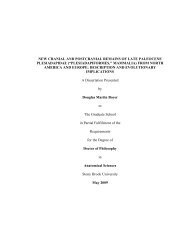Changes in nearest-neighbor associations in a captive group of ...
Changes in nearest-neighbor associations in a captive group of ...
Changes in nearest-neighbor associations in a captive group of ...
You also want an ePaper? Increase the reach of your titles
YUMPU automatically turns print PDFs into web optimized ePapers that Google loves.
272 McCann and Rothman<br />
Fig. 4. a: Proximity (mean meters + s.e.) <strong>of</strong> sub-adult and adult females (n = 390 scans) and <strong>in</strong>fants<br />
(n = 226 scans) to the silverback male. b: Proximity (mean meters + s.e.) <strong>of</strong> sub-adult and adult<br />
females to the silverback male before (hatched columns) (n = 164 scans) and after (solid columns) (n =<br />
226 scans) <strong>in</strong>fants were <strong>in</strong>troduced. Significant differences (P ≤ 0.05) between before and after were<br />
determ<strong>in</strong>ed by the Student t-test and <strong>in</strong>dicated by an asterisk.<br />
<strong>in</strong>fant was <strong>nearest</strong> <strong>neighbor</strong> to an adult or sub-adult was calculated. Based on this<br />
value, it was expected that if sex were a factor, it would be biased toward the samesex<br />
adult. It was found that the <strong>nearest</strong> <strong>neighbor</strong> <strong>of</strong> female I1 and the male tw<strong>in</strong>s (I4<br />
and I5) was most frequently silverback male M1 (χ 2 = 21.2, P = 0.001; χ 2 = 29.6, P =<br />
0.001; χ 2 = 29.5, P = 0.001, respectively). This result was found to be non-random.<br />
Female I3’s <strong>nearest</strong> <strong>neighbor</strong> was also non-random; she frequently associated with<br />
sub-adult female S1 (χ 2 = 43.2, P = 0.001). Female I2’s adult <strong>nearest</strong> <strong>neighbor</strong>, however,<br />
was random (χ 2 = 4.75, P = 0.001).






